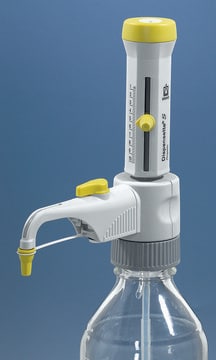11426320001
Roche
Anti-Fluorescein
from mouse IgG1 (clone B13-DE1)
Sinónimos:
antibody
Iniciar sesiónpara Ver la Fijación de precios por contrato y de la organización
About This Item
Código UNSPSC:
12352200
Productos recomendados
origen biológico
mouse
conjugado
unconjugated
forma del anticuerpo
purified immunoglobulin
tipo de anticuerpo
primary antibodies
clon
B13-DE1, monoclonal
Formulario
lyophilized
envase
pkg of 100 μg
fabricante / nombre comercial
Roche
isotipo
IgG1
temp. de almacenamiento
2-8°C
Descripción general
Monoclonal antibody to fluorescein.
The detection of bound antibody can be carried out directly in one step using an anti-mouse Ig fluorochrome/enzyme conjugate, or in a two-step procedure with anti-mouse Ig fluorescein and, subsequently, anti-fluorescein enzyme conjugate.
The antibody does not contain any protein and can hence be used for coating and labeling.
Contents
Lyophilizate, stabilized
The detection of bound antibody can be carried out directly in one step using an anti-mouse Ig fluorochrome/enzyme conjugate, or in a two-step procedure with anti-mouse Ig fluorescein and, subsequently, anti-fluorescein enzyme conjugate.
The antibody does not contain any protein and can hence be used for coating and labeling.
Contents
Lyophilizate, stabilized
Especificidad
The monoclonal antibody reacts with free and bound fluorescein.
Aplicación
Use Anti-Fluorescein for the detection of fluorescein-labeled compounds using:
- ELISA
- Immunohistocytochemistry
- In situ hybridization
- Western blot
Nota de preparación
Working concentration: Working concentration of conjugate depends on application and substrate. The following concentrations should be taken as a guideline:
Working solution: Phosphate buffered saline, pH 7.4
Using water instead the antibody can precipitate.
- ELISA: 2 to 4 μg/ml
- Immunohistocytochemistry: 0.5 to 2 μg/ml
- In situ hybridization: 0.2 to 0.4 μg/ml
- Western blot: 0.5 to 2 μg/ml
Working solution: Phosphate buffered saline, pH 7.4
Using water instead the antibody can precipitate.
Reconstitución
Add 1 ml double-distilled water to a final concentration of 100 μg/ml.
Reconstitute for 15 minutes.
Reconstitute for 15 minutes.
Otras notas
For life science research only. Not for use in diagnostic procedures.
¿No encuentra el producto adecuado?
Pruebe nuestro Herramienta de selección de productos.
Palabra de señalización
Warning
Frases de peligro
Consejos de prudencia
Clasificaciones de peligro
Aquatic Chronic 3 - Skin Sens. 1
Código de clase de almacenamiento
11 - Combustible Solids
Clase de riesgo para el agua (WGK)
WGK 2
Punto de inflamabilidad (°F)
does not flash
Punto de inflamabilidad (°C)
does not flash
Elija entre una de las versiones más recientes:
¿Ya tiene este producto?
Encuentre la documentación para los productos que ha comprado recientemente en la Biblioteca de documentos.
Yufeng Liu et al.
Oncology reports, 44(2), 499-508 (2020-07-07)
Apurinic/apyrimidinic endonuclease 1 (APE1) is a primary nuclear‑localized multifunctional protein in osteosarcoma. However, the cytoplasmic localization of APE1 was found to be functional and to increase with cisplatin resistance, yet the molecular mechanism is unknown. In the present study, we explored
Gerard Terradas et al.
G3 (Bethesda, Md.), 12(1) (2021-11-19)
Gene drives are programmable genetic elements that can spread beneficial traits into wild populations to aid in vector-borne pathogen control. Two different drives have been developed for population modification of mosquito vectors. The Reckh drive (vasa-Cas9) in Anopheles stephensi displays
María Fernanda Prado-Fernández et al.
Current issues in molecular biology, 46(7), 6885-6902 (2024-07-26)
Pereskia sacharosa Griseb. is a plant used in traditional herbal medicine to treat inflammation. We analyzed the phenolic content of P. sacharosa leaves (EEPs) by liquid chromatography-tandem mass spectrometry (LC-MS/MS) and investigated the anti-inflammatory properties of EEPs and its flavonoid
Ignacio E Schor et al.
Current biology : CB, 28(22), 3547-3561 (2018-11-06)
Long non-coding RNAs (lncRNAs) can often function in the regulation of gene expression during development; however, their generality as essential regulators in developmental processes and organismal phenotypes remains unclear. Here, we performed a tailored investigation of lncRNA expression and function
Comparing nucleic acid lateral flow and electrochemical genosensing for the simultaneous detection of foodborne pathogens.
Aissa A B, et al.
Biosensors And Bioelectronics, 88, 265-272 (2017)
Nuestro equipo de científicos tiene experiencia en todas las áreas de investigación: Ciencias de la vida, Ciencia de los materiales, Síntesis química, Cromatografía, Analítica y muchas otras.
Póngase en contacto con el Servicio técnico







